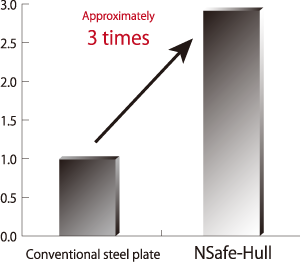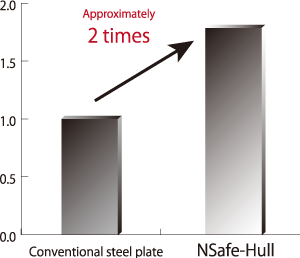NSafe-Hull is a highly ductile steel plates in which the ductility has been improved by the optimum use of Nippon Steel’s original chemical composition design. When an impact force is applied to a ship, it is absorbed by denting of the plates themselves.
"NSafe™-Hull" -Highly ductile steel plates developed by original chemical composition design
NSafe-Hull is a highly ductile steel plates in which the ductility has been improved by the optimum use of Nippon Steel’s original chemical composition design. When an impact force is applied to a ship, it is absorbed by denting of the plates themselves. In the NSafe-Hull, the capacity to absorb collision energy has been improved three times over that of conventional plates. The critical striking ship speed is twice that of conventional plates as well. Consequently the high ductility offered by NSafe-Hull can increase the period in which cracks and ruptures occur in plates.
For example, even if a crude oil tanker is in an accident, NSafe-Hull can prevent the oil spill into the sea. NSafe-Hull contributes toward safer and securer marine transport of tankers, cargo ships and other types of ships
Nearly tripling the capacity of a ship to absorb collision energy and nearly doubling the critical striking ship speed for penetration* over conventional steel plates.
Study on ship collision has led to the development of NSafe-Hull, a new plate that is suitable for a wider range of applications, including cargo hold hull and fuel oil tanks. NSafe-Hull’s high ductility is achieved by the original chemical composition design and crystaline size-order microstructural control. Its workability (shearing, bending, welding and painting) is identical to those of conventional steels. The safety and security only NSafe-Hull provides is now available to users.
* Critical striking ship speed: The maximum speed at which penetration does not occur after collision

"NSafe™-Hull" -Penetrating rupture-free performance even in a 12-knot collision
The stated performance of NSafe-Hull has been proved by collision simulations at the National Maritime Research Institute, Japan. The simulation results demonstrate that the penetration does not occur in the inner hull of double-hull structure of a crude oil tanker employing NSafe-Hull in the case of the maximum strike speed of 12 knots. In the case of the bulk carrier with NSafe-Hull, simulation results confirmed that the penetration does not occur in the single hull structure at the maximum speed of 5 knots. NSafe-Hull is assessed to be a shipbuilding steel plate that can prevent oil spill that might otherwise cause huge environmental damages, as well as massive cargo discharge and even human injury. NSafe-Hull leadss another evolutionary step in the enhancement of maritime safety.
* Figures: Schematic image of simulation results

Absorbed Energy by Struck Ship, Normarised
Absorbed energy by struck ship, normalised by value of case with conventional steel.

Critical Striking Ship Speed for Penetration, Normarised
Critical striking ship speed for penetration, normalised by value of case with conventional steel

Highly corrosion-resistant NSGP features both paint-free application and high performance...
→
The use of abrasion resistant ABREX steel plate markedly reduces the weight of structural...
→
Weathering Steel COR-TEN™ has overcome rust, which is the weakest point of steel, in a uni...
→
"CORSPACE™" substantially suppresses corrosion by addition of a small amount of tin. Compa...
→
The technology employed in the development of this steel received the Ichimura Industrial...
→
